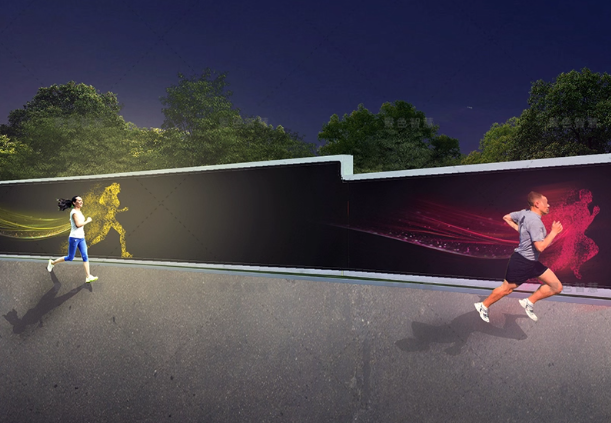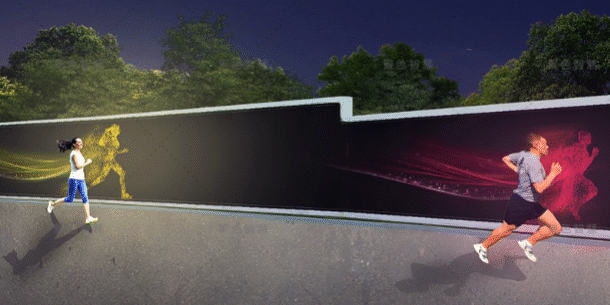Introduction: Turning Every Run Into an Interactive Experience
As fitness spaces evolve into smarter, more immersive environments, LiDAR projection walls have emerged as one of the most futuristic innovations in the fitness and public wellness sector. These systems allow runners to see a virtual avatar that mirrors their movement—in real time—on a wall, without wearing any tracking device.
This article explains how LiDAR projection interactive running walls achieve synchronized virtual companions, diving into the technical principles and core workflow behind this engaging, contactless fitness experience.

What Is a LiDAR Projection Running Wall?
A LiDAR projection interactive running wall is a high-tech system that captures a runner’s motion using laser radar sensors and visually replicates it via dynamic projection. The result? A virtual running partner that matches your pace and position on a wall—offering both entertainment and training value.
Unlike systems that rely on cameras or wearable trackers, LiDAR delivers accurate, real-time tracking of human movement using laser pulses, making it suitable for public spaces, gyms, and smart fitness parks.
How Does a LiDAR Projection Wall Achieve Real-Time Synchronized Avatars?
Let’s break down the process into four essential steps:
1. LiDAR Spatial Positioning and Motion Capture
At the heart of the system is a LiDAR sensor—a device that emits laser pulses and calculates the time it takes for each pulse to bounce back from an object (in this case, a person).
- LiDAR scans the runner and captures precise 3D spatial data.
- It tracks real-time position, direction, speed, and motion patterns.
- The scanning frequency is high enough to detect even small, fast movements, ensuring ultra-low latency.
Unlike camera-based systems, LiDAR performs well in all lighting conditions and doesn’t require the user to stand in a fixed position or wear any device.
2. Data Transmission and Computational Processing
Once the LiDAR sensor collects spatial and movement data, this information is transmitted instantly to a central processing system (computer or server).
- The system identifies the runner’s body outline and motion behavior.
- It applies algorithms to interpret direction, stride, and rhythm.
- The data is then synchronized and optimized for visual rendering.
This stage is crucial—it ensures that the avatar on the wall moves in real time and with high fidelity, without lags or glitches.
3. Generation of a Dynamic Avatar or Virtual Companion
The processed movement data is transformed into a dynamic virtual image or avatar. This image reflects the runner’s actions and speed on a visual interface.
- The system creates a virtual character that mirrors the runner’s movements.
- It adapts the animation in real time to match motion speed and posture.
- The avatar can also be styled for gamification or training (e.g., professional runner, animated character, or visual effects like speed trails).
This stage bridges the physical world with a digital representation, enriching the running experience with interactive visual elements.
4. Projection of the Synchronized Avatar on the Wall
Finally, a high-resolution projector displays the virtual image directly onto the running wall. This is where the magic becomes visible.
- The projected avatar runs side-by-side with the user, maintaining exact position and timing.
- The system can even include interactive lighting effects, color changes, or feedback based on the runner’s performance.
- As the user moves, the system responds dynamically, making every run unique and immersive.
The entire pipeline—from data capture to projection—takes milliseconds, enabling seamless motion synchronization that feels immediate and natural.
Why This Technology Stands Out
Unlike traditional exercise systems, the LiDAR projection running wall is:
- Contactless and wearable-free: Perfect for public use or hygienic environments.
- Highly accurate: LiDAR can detect fine-grained movements that cameras or IR sensors might miss.
- Responsive in real time: No delays or sync issues, which is critical for immersive interaction.
- Flexible for all ages and abilities: Easy to engage with; no technical skill needed.
- Visually dynamic and customizable: Allows for gamified elements, training modes, or themed characters.
Real-World Applications
This technology is now being adopted in:
Smart Fitness Parks
Encouraging public wellness with interactive, high-tech exercise facilities.
Indoor Gyms and Fitness Studios
Used as a motivational training aid that combines cardio with visual stimulation.
Schools and Youth Centers
Fun and interactive PE tools for children and teens.
Corporate and Commercial Spaces
As part of wellness programs and tech-forward recreation zones.
Conclusion: The Future of Fitness Is LiDAR-Driven
By combining the precision of LiDAR, the power of real-time computing, and the immersive potential of dynamic projection, these systems transform an ordinary workout into an engaging, gamified experience. With the rise of smart fitness and contactless interaction, LiDAR projection running walls are leading a new era of active environments—accessible, fun, and forward-thinking.
Call to Action
At CPJROBOT, we specialize in the research, development, and manufacturing of POE interactive LiDAR and industrial-grade radar sensors. Whether you’re building a smart fitness park, developing an immersive exhibition, or customizing motion-sensing solutions, our team is ready to provide tailored support and OEM/ODM services.
Contact CPJROBOT today to explore how our LiDAR solutions can power your next interactive project.







